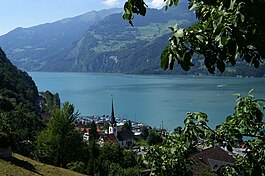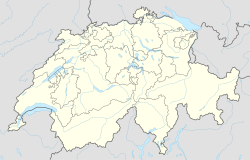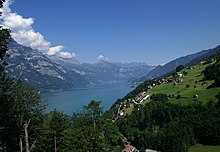
Spiringen is a village and a municipality in the canton of Uri in Switzerland. The municipality comprises two disjoint areas, separated by the municipality of Unterschächen and the Klausen Pass. The western area includes the village of Spiringen in the Schächen Valley, whilst the eastern area includes the Urner Boden alp above Linthal and the canton of Glarus.

Bilten is a former municipality in the canton of Glarus in Switzerland. Effective from 1 January 2011, Bilten is part of the municipality of Glarus Nord.
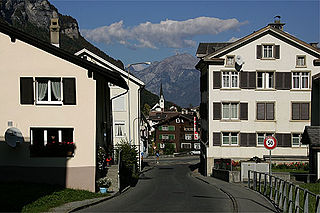
Linthal is a village and former municipality in the municipality of Glarus Süd and canton of Glarus in Switzerland. The village lies near the head of the valley of the Linth river, and at the foot of the Klausen Pass into the canton of Uri. It is the terminus of the railway line that traverses the length of Glarus.

Betschwanden is a village and former municipality in the municipality of Glarus Süd and canton of Glarus in Switzerland.

Ennenda is a former municipality in the canton of Glarus in Switzerland. Effective from 1 January 2011, Ennenda is part of the municipality of Glarus.

Filzbach is a former municipality in the canton of Glarus in Switzerland. Effective from 1 January 2011, Filzbach is part of the municipality of Glarus Nord.

Haslen is a village, and former municipality, in the municipality of Glarus Süd and canton of Glarus in Switzerland.

Luchsingen is a village and former municipality in the municipality of Glarus Süd and canton of Glarus in Switzerland.

Matt is a village, and former municipality, in the municipality of Glarus Süd and canton of Glarus in Switzerland. Matt lies in the valley of the Sernf river, and consists of the village of Matt itself, and the mountain hamlet of Weissenberge.

Mitlödi is a village and former municipality, in the municipality of Glarus Süd and canton of Glarus in Switzerland.
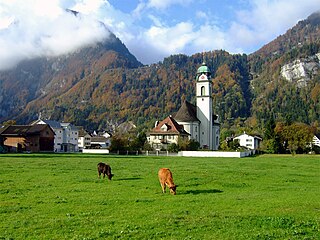
Näfels is a former municipality in the canton of Glarus in Switzerland. Effective from 1 January 2011, Näfels is part of the municipality of Glarus Nord.

Netstal is a former municipality in the canton of Glarus in Switzerland. Effective from 1 January 2011, Netstal is part of the municipality of Glarus.

Sool is a village, and former municipality, in the municipality of Glarus Süd and canton of Glarus in Switzerland.

Schwanden is a village, and former municipality, in the municipality of Glarus Süd and canton of Glarus in Switzerland.

Schwändi is a village, and former municipality, in the municipality of Glarus Süd and canton of Glarus in Switzerland.

Rüti is a village, and former municipality, in the municipality of Glarus Süd and canton of Glarus in Switzerland.

Obstalden is a former municipality in the canton of Glarus in Switzerland. Effective from 1 January 2011, Obstalden is part of the municipality of Glarus Nord.

Riedern is a former municipality in the canton of Glarus in Switzerland. Effective from 1 January 2011, Riedern is part of the municipality of Glarus.

Niederurnen is a former municipality in the canton of Glarus in Switzerland. Effective from 1 January 2011, Niederurnen is part of the municipality of Glarus Nord.

Oberurnen is a former municipality in the canton of Glarus in Switzerland. Effective from 1 January 2011, Oberurnen is part of the municipality of Glarus Nord.
